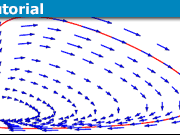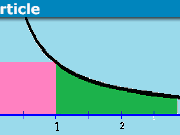Solving Homogeneous Linear ODEs using Annihilators
In this Insights article we’ll look at a limited class of ordinary differential equations — homogeneous linear ODES with constant coefficients. Although there are many differential equations that are outside the scope of this article, there are many applications in mechanics and electronics of the types of differential equations we’ll be looking at.
Table of Contents
Homogeneous Equations
A homogeneous differential equation consists of a linear combination of an unknown function and its derivatives, that is equal to zero. Symbolically, a homogeneous differential equation has the form F(y, y’, y”, …) = 0.
Let’s look at two examples:
- y’ – 3y = 0
- y” – 4y’ + 3y = 0
Ex. 1: The first example is a first order, constant coefficient, homogeneous, linear differential equation. One technique that is commonly used is to assume that the solution is of the form y = ##e^{rt}##.
Differentiating, we get y’ = ##re^{rt}##. Substituting for y and y’ in the original equation, we get ##re^{rt} – 3e^{rt} = 0##, or ##e^{rt}(r – 3) = 0##.
Since ##e^{rt}## is never zero for real r and t, it must be true that r – 3 = 0. Here, r – 3 = 0 is the characteristic equation for this differential equation. It should be clear that the solution of the characteristic equation is r = 3.
Thus, a solution is y(t) = ##e^{3t}##. Any constant multiple of this function is also a solution, so the general solution for Example 1 is ##y(t) = ce^{3t}##.
Ex. 2: The second example, y” – 4y’ + 3y = 0, is a second order, constant coefficient, homogeneous, linear differential equation. If we again assume a solution of the form y = ##e^{rt}##, then, by differentiating twice, we get:
##y’ = re^{rt}##
##y” = r^2e^{rt}##
Substituting for y, y’, and y” in the original differential equation, we have
$$r^2e^{rt} – 4re^{rt} + 3e^{rt} = 0$$.
Or, by pulling out the common factor, ##e^{rt}(r^2 – 4r + 3) = 0##. In this example, the characteristic equation is ##r^2 – 4r + 3 = 0##.
Since ##e^{rt}## is never zero for real r and t, we must have ##r^2 – 4r + 3 = 0##, or (r – 3)(r – 1) = 0.
So the solutions to the characteristic equation are r = 3, or r = 1.
Two solutions of the differential equation are ##y_1(t) = e^{3t}## and ##y_2(t) = e^{t}##. I will state without explanation that these two functions form a basis for the solution space of this differential equation, which is spanned by the set of all linear combinations of these two functions. This tells us that the general solution of the differential equation is ##y(t) = c_1e^{3t} + c_2e^{t}##.
Annihilators
The Annihilator method uses the notation of D for the derivative operator, the derivative with respect to the independent variable of whatever the D operator is applied to. For example, Dy is the same as ##\frac{d}{dt}y##.
In the first example we looked at, the differential equation was y’ – 3y = 0. Using the D notation, we can rewrite this equation as (D – 3)y = 0. You might remember that the characteristic equation of the first differential equation was r – 3 = 0. The similarity between the characteristic equation and our revised version of the differential equation are not accidental. However, there are differences between these two equations. In the former equation, D and D – 3 are operators, while in the latter equation, r is a number. The D operator, as already mentioned, takes the derivative of whatever it is applied to, and the D – 3 operator takes the derivative of and subtracts from that three times whatever it is applied to. Using the solution we already found (y(t) = ##ce^{3t}##), (D – 3)y = Dy – 3y = ##3ce^{3t} – 3ce^{3t} = 0##.
For the differential equation of our first example, the D – 3 operator “annihilates” (or zeroes out) our solution function.
If we now turn to the second example, y” – 4y’ + 3y = 0, we see that this equation can be rewritten as ##(D^2 – 4D + 3)y = 0##, where ##D^2## denotes taking the second derivative of whatever it is applied to. Recall that the characteristic equation for this differential equation was ##r^2 – 4r + 3 = 0##, which we factored into (r – 3)(r – 1) = 0 to get our solutions: r = 3 and r = 1.
In a similar fashion, ##D^2 – 4D + 3## can be “factored” into (D – 3)(D – 1). “Factored” is in quotes because we’re not really multiplying (D – 3) and (D – 1) here. The operations are more like function composition than multiplication, but applying the D – 1 operator, followed by appling the D – 3 operator is the same as applying the ##D^2 – 4D + 3## operator, so the abuse of notation does no harm. Just as before, we used the factored form of the characteristic equation — (r – 3)(r – 1) = 0 — to get our fundamental solutions, ##y_1(t) = e^{3t}## and ##y_2(t) = e^t##, we can use the factored form (D – 3)(D – 1)y = 0, to get our fundamental solutions.
In this case, the D – 3 operator annihilates any constant multiple of ##e^{3t}##, and the D – 1 operator annihilates any constant multiple of ##e^t##. Together, as (D – 3)(D – 1), the combined operator annihilates any linear combination (sum of constant multiples) of ##e^{3t}## and ##e^t##.
Repeated Roots of the Characteristic Equation
Ex. 3: y” – 2y’ + y = 0
Using the same technique as before, we see that the characteristic equation is ##r^2 – 2r + 1 = 0##, or ##(r – 1)^2 = 0##. From this we see that the only root is r = 1. Because this is a second-order differential equation, we need two linearly independent solutions for our fundamental set of solutions. Clearly (I hope), one such solution is ##y_1(t) = e^t##. The standard trick when there are repeated roots of the characteristic equation, is to set ##y_2(t) = te^t##. I won’t prove why this works, but you should satisfy yourself that ##y_2(t)## is indeed a solution of the differential equation of this example.
Rewriting the differential equation as ##(D^2 – 2D + 1)y = 0##, or ##(D – 1)^2y = 0##, we see that the ##(D – 1)^2## operator annihilates both ##e^t## and ##te^t##. You can verify this for yourself by noting that ##(D – 1)(te^t) = e^t##, and that ##(D – 1)(e^t) = 0##. Thus ##(D – 1)^2(te^t) = 0##. It is also true that ##(D – 1)^2 (e^t) = 0##.
From this work, our general solution to the differential equation of this example is ##y(t) = c_1e^t + c_2te^t##.
Note: Many applied problems in mechanics, such as a mass hanging from a spring with a damping mechanism, are modeled by this type of differential equation. In addition, problems in electronics, with an inductor, resistor, and capacitor, are also modeled by a differential equation similar to this one.
Ex. 4: y”’ – 6y” + 12y’ – 8y = 0
Here we have our first third-order differential equation, so a general solution will need to incorporate three linearly independent functions.
A little work shows that the characteristic equation is ##r^3 – 6r^2 + 12r – 8 = 0##, which can be factored to ##(r – 2)^3 = 0##. The root of this equation is r = 2, and it is repeated.
Similar to the previous example, we see that a fundamental set of solutions is {##e^{2t}, te^{2t}, t^2e^{2t}## }. Again, I won’t go into details about why these are the correct solutions, but you can verify for yourself that each of them satisfies the differential equation of this example.
Writing the differential equation in operator notation, we have ##(D^3 – 6D^2 + 12D – 8)y = 0##, or ##(D – 2)^3 y = 0##. The ##(D – 3)^3## operator annihilates, ##e^{2t}, te^{2t},## and ##t^2e^{2t}##. I’ll leave the verification of this statement to you.
For the differential equation of this example, the general solution is ##y(t) = c_1e^{2t} + c_2te^{2t} + c_3t^2e^{2t}##.
Complex Roots of the Characteristic Equation
Ex. 5: y” + 4y = 0
Applying the same technique as before, we see that the characteristic equation is ##r^2 + 4 = 0##, or ##r = \pm 2 i##. From this we conclude that a fundamental set of solutions is ##\{e^{2it}, e^{-2it} \}##, where ##i = \sqrt{-1}##.
By using Euler’s Formula, we can rewrite these two functions as ##e^{2it} = \cos(2t) + i\sin(2t)##, and ##e^{-2it} = \cos(2t) – i\sin(2t)##.
Our fundamental solutions span the set of all solutions, so linear combinations of these two functions could also be used to make up the fundamental set of solutions.
If we note that ##\frac 1 2 (\cos(2t) + i \sin(2t)) + \frac 1 2 (\cos(2t) – i \sin(2t)) = \cos(2t)##, and that ##\frac 1 {2i} (\cos(2t) + i \sin(2t)) – \frac 1 {2i} (\cos(2t) – i \sin(2t)) = \sin(2t)##, we find that by taking judicious linear combinations of ##e^{2it}## and ##e^{-2it}##, we can get a different fundamental solution set that doesn’t involve that pesky i; namely, ##\{\cos(2t), \sin(2t)\}##. The advantage here is that these functions are purely real.
Rewriting the differential equation in operator notation, we have ##(D^2 + 4)y = 0##. From this, we see that the ##(D^2 + 4)## operator annihilates both cos(2t) and sin(2t). You can verify this for yourself by taking the second derivative of each function, and subtracting the function from the result of differentiating twice.
The general solution for this example is ##y(t) = c_1 \cos(2t) + c_2\sin(2t)##.
Example 5 concludes this Insights article. In the next Insights article, Solving Nonhomogeneous Linear ODEs using Annihilators, we will apply the ideas presented here to tranform nonhomogeneous differential equations into higher-order homogeneous equations, using the concept of annihilators.
Former college mathematics professor for 19 years where I also taught a variety of programming languages, including Fortran, Modula-2, C, and C++. Former technical writer for 15 years at a large software firm headquartered in Redmond, WA. Current associate faculty at a nearby community college, teaching classes in C++ and computer architecture/assembly language.
I enjoy traipsing around off-trail in Olympic National Park and the North Cascades and elsewhere, as well as riding and tinkering with my four motorcycles.






[QUOTE="zhiyang, post: 5494546, member: 596479"]For example, in example 1, by assuming the solution takes the form of e^(rt), we can solve for r since r is a number. But without making this assumption, how do i get the solution y = c e^(3t) from (D-3)y = 0?[/QUOTE]If you are working with a linear, constant coefficient, homogeneous differential equation, it is reasonable to assume that the solution has the form y = ce[SUP]rt[/SUP].(D – 3)y = 0is the same as Dy – 3y = 0, or equivalently, y' = 3y, where y' means ##frac{dy}{dt}##.The DE y' = 3y is separable, and can be solved fairly easily to get the general solution: y(t) = Ce[SUP]3t[/SUP].
[QUOTE="zhiyang, post: 5494546, member: 596479"]Hi! I am new to physicsforum. I am not sure how to post a reply/question on the article page so I am doing it here. I am also not very good at math at the moment.My question is suppose we do not make any assumptions (that the solution is in the form y = e^(rt)), using the annihilator method, how do I find the general solution?For example, in example 1, by assuming the solution takes the form of e^(rt), we can solve for r since r is a number. But without making this assumption, how do i get the solution y = c e^(3t) from (D-3)y = 0?[/QUOTE]You need to take into consideration the homogenous part of the equation. Let's take y=y[SUB]c[/SUB] + y[SUB]p[/SUB], why y[SUB]c[/SUB] is the homogenous part of the equation. You take the annihlator for the right hand side of the original equation and multiply both sides by that, giving you 0 on the right hand side and the differential operators on the left hand side. Next you find all the possible solutions for D where the right hand side would equal to 0. After you have all the values for D such that the right hand side gives you 0 you right out the solutions like you would for an ODE, and you just eliminate the solutions that are repeating from the homogenous part and keep the non repeating solutions as the "guess" to the trial function that you need for the particular solution. Thereafter you can use the left hand and use the method of undetermined co-efficients.
Hi! I am new to physicsforum. I am not sure how to post a reply/question on the article page so I am doing it here. I am also not very good at math at the moment.My question is suppose we do not make any assumptions (that the solution is in the form y = e^(rt)), using the annihilator method, how do I find the general solution?For example, in example 1, by assuming the solution takes the form of e^(rt), we can solve for r since r is a number. But without making this assumption, how do i get the solution y = c e^(3t) from (D-3)y = 0?
[QUOTE=”carllrac, post: 5328548, member: 549743″]typo. 1/2i(cos(t)+isin(t))+1/2i(cos(t)–isin(t))=sin(t) has + instead of -. Should be -1/2i(cos(t)–isin(t))[/QUOTE]
Thank you for spotting this. I have fixed this typo as well as another in that section.
typo. 1/2i(cos(t)+isin(t))+1/2i(cos(t)–isin(t))=sin(t) has + instead of -. Should be -1/2i(cos(t)–isin(t))
[QUOTE=”ElijahRockers, post: 5314118, member: 321900″]I’m having a hard time seeing what the point is. It looks to me that the annihilators are the same thing as the characteristic equation.
What am I missing?[/QUOTE]
The differential equation in operator notation is closely related to the characteristic equation. With homogeneous diff. equations, there isn’t much point, but you can use annihilators to convert [U]some[/U] nonhomogeneous diff. equations to a higher-order homogeneous equation. That is covered in the second article, [URL=’https://www.physicsforums.com/insights/solving-nonhomogeneous-linear-odes-using-annihilators/’]Solving Nonhomogeneous Linear ODEs using Annihilators[/URL].
Thank you very much for your artical. Please teach about "Series Solutions‐ Frobenius‘ Method".
I'm having a hard time seeing what the point is. It looks to me that the annihilators are the same thing as the characteristic equation.What am I missing?